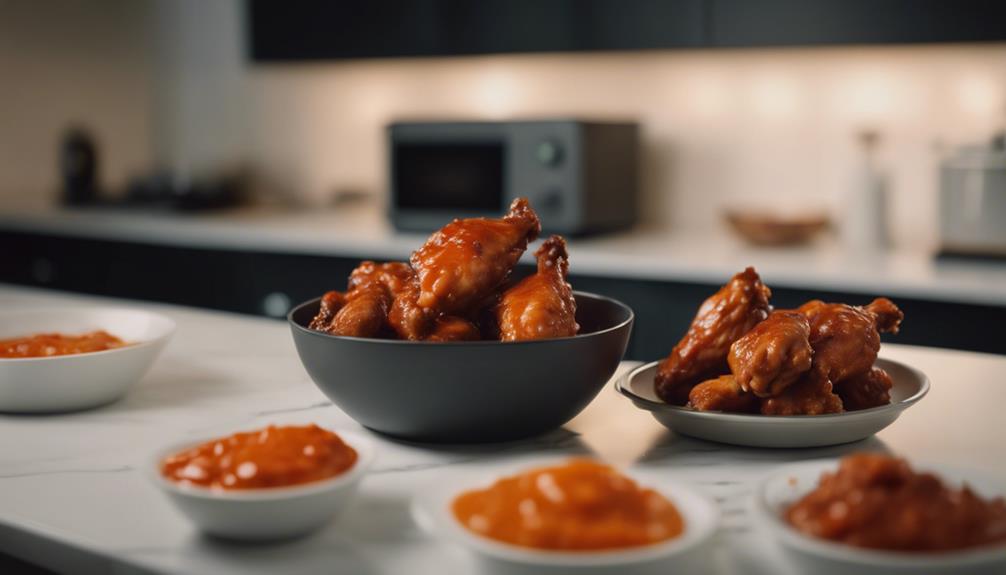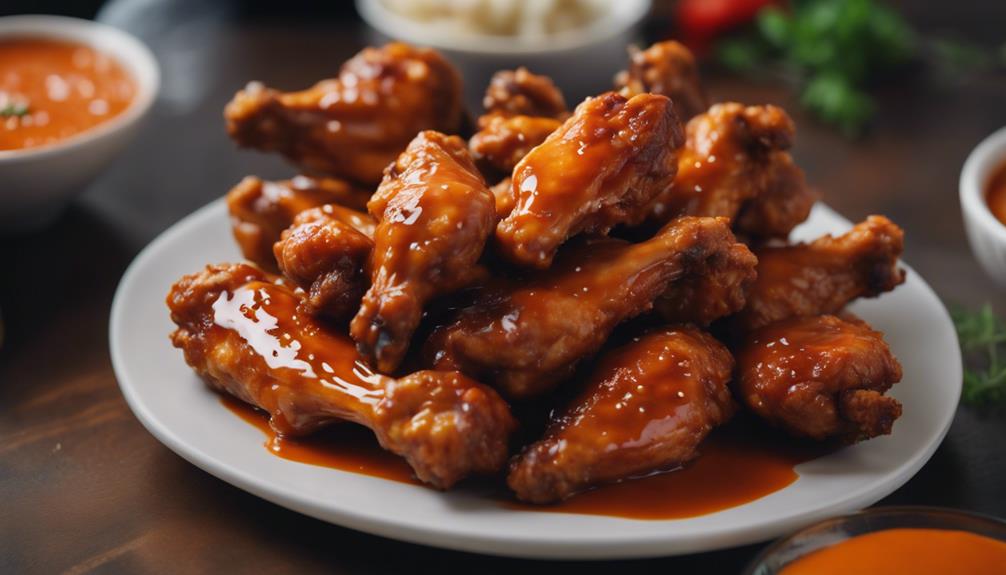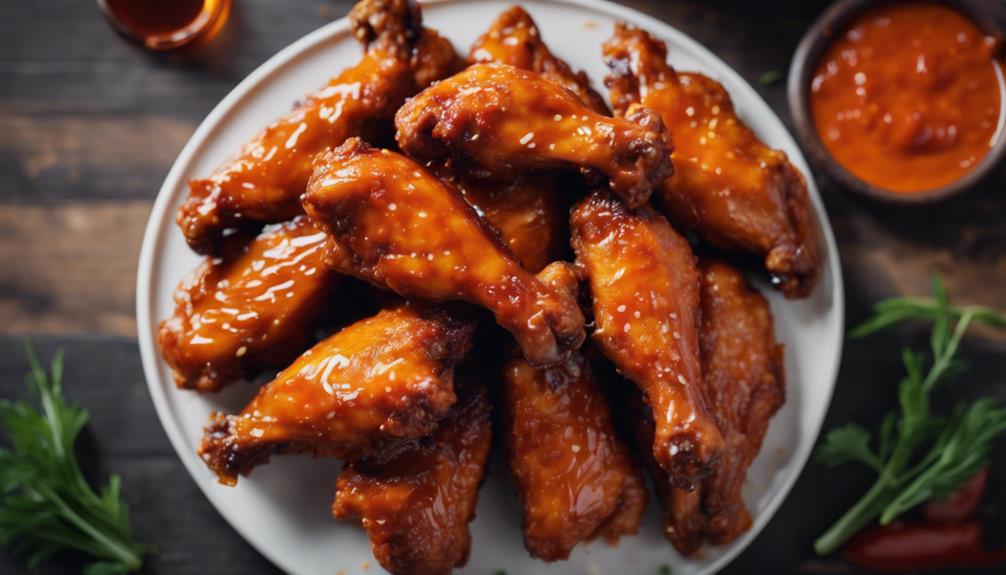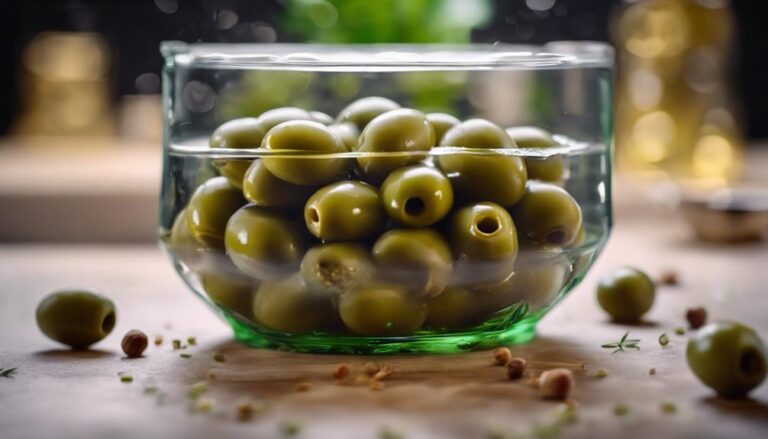Sous Vide Chicken Wings With Homemade Buffalo Sauce
Enhance your chicken wing game with succulent sous vide wings smothered in homemade buffalo sauce. Achieve unparalleled tenderness and flavor that will leave you yearning for more. The precise cooking method guarantees each bite is juicy and perfectly seasoned, establishing a new standard for wing perfection. Embark on a culinary adventure where each bite promises a burst of savory goodness. Master the art of buffalo wings in a way that will have your taste buds singing with delight. Explore the world of incredible wing creations that will revolutionize your palate. Uncover the secrets to creating the ultimate chicken wing experience.
What You Will Learn Here
- Sous vide method ensures tender, juicy wings.
- Homemade Buffalo sauce enhances flavor authenticity.
- Precise temperature control is crucial for optimal cooking.
- Seal wings in airtight bags before sous vide cooking.
- Finish wings in the oven for crispy texture after sous vide.
Chicken Wing Origins

Chicken wings have a fascinating history deeply intertwined with cultural practices and traditions.
The invention of the Buffalo wing is a culinary legend that has sparked a global love for this spicy treat.
The popularity of chicken wings spans across continents, showcasing the versatility and appeal of this beloved dish.
Wing History and Culture
Tracing the origins of the beloved chicken wing reveals a fascinating journey through culinary history and cultural significance. From humble beginnings as a throwaway part of the chicken, wings have soared to become a symbol of indulgence and communal enjoyment.
Wing festivals celebrate this iconic food, where enthusiasts gather to sample a variety of flavors and cooking styles. Wing eating contests push the boundaries of consumption, showcasing both the competitive spirit and the creativity in preparing this versatile dish.
Over time, chicken wings have evolved from a cheap snack to a culinary sensation, influencing menus worldwide and sparking a craze for innovative recipes. The popularity of wings transcends borders, uniting people in their love for this crispy, flavorful treat.
Buffalo Wing Invention
Amid the culinary landscape of America's 1960s, a spicy and tangy creation emerged, forever altering the course of chicken wing history: the Buffalo wing. This iconic dish marked a significant milestone in wing flavor evolution, sparking the Buffalo wing craze that continues to captivate taste buds worldwide.
The combination of crispy wings drenched in a zesty hot sauce became a sensation, paving the way for a new era in wing cooking techniques. While traditional frying methods have long been favored, innovative approaches like the sous vide method are revolutionizing how wings are prepared, ensuring a perfect balance of tenderness and flavor infusion.
The Buffalo wing's inception not only revolutionized the way we enjoy chicken wings but also inspired a wave of culinary creativity in the domain of finger-licking goodness.
Global Wing Popularity
Among the myriad culinary marvels originating from various corners of the globe, the humble yet versatile wing has secured a prominent place in the hearts and plates of food enthusiasts worldwide.
Wing flavors span a spectrum as diverse as the cultures they represent, from the fiery spices of Buffalo wings to the tangy sweetness of Asian-inspired sauces.
Wing cooking techniques have evolved beyond traditional frying, embracing methods like grilling, baking, and even sous vide, offering unique textures and flavors.
Whether coated in a sticky glaze or dusted with exotic spices, wings continue to captivate taste buds globally.
As global influences collide, the world of wing cuisine remains a dynamic and ever-expanding domain, inviting culinary adventurers to explore its endless possibilities.
Wing Sauce Varieties

When exploring wing sauce varieties, you'll encounter a diverse range of flavors and heat levels to suit every preference and palate. The world of wing sauces offers a playground of creativity and taste sensations. Here are some key considerations to keep in mind:
- Unique Flavor Combinations: Wing sauce pairings offer endless possibilities for flavor experimentation. From tangy teriyaki to sweet and spicy honey sriracha, the options are as vast as your imagination.
- Homemade vs Store Bought: When it comes to wing sauces, the debate between homemade and store-bought is ongoing. Homemade sauces allow for complete customization and quality control, while store-bought options often provide convenience. Taste comparison reveals that homemade sauces tend to have fresher flavors and a more authentic taste.
- Heat Levels: Whether you prefer mild, medium, or extra hot, wing sauces come in a variety of heat levels to cater to different spice tolerances. Experimenting with different heat levels can elevate the flavor profile of your wings and keep things exciting.
Tasty Chicken Wing Creations
When it comes to tasty chicken wing creations, you have a variety of tempting options to choose from.
Succulent Honey Garlic Wings, Spicy Korean Wings, and Zesty Lemon Pepper Wings are just a few examples that will tantalize your taste buds.
Each of these flavors provides a unique and flavorful twist to the classic chicken wing, making them a must-try for any wing enthusiast.
Succulent Honey Garlic Wings
Sink your teeth into the irresistibly savory and sweet combination of succulent honey garlic wings, a delightful addition to your repertoire of tasty chicken wing creations. These wings offer a perfect balance of flavors that will leave your taste buds craving more.
Here are three reasons why these wings are a must-try:
- Tender Perfection: The honey garlic marinade guarantees the wings are juicy and tender, packed with flavor in every bite.
- Sweet and Savory Harmony: The blend of honey and garlic creates a harmonious taste profile, elevating these wings to a whole new level.
- Versatile Crowd-Pleaser: Whether served at intimate gatherings or on grand wing platters, these honey garlic wings are sure to impress even the most discerning palates.
Spicy Korean Wings
Get ready to experience a fiery explosion of flavors with the bold and zesty Spicy Korean Wings, a tantalizing addition to your collection of mouthwatering chicken wing recipes. When it comes to these wings, the fusion of spicy marinade options with traditional Korean flavors creates a unique and unforgettable taste experience.
Here are some key points to keep in mind:
- Spicy Marinade Options: Experiment with different levels of heat by adjusting the amount of Korean chili paste or red pepper flakes in your marinade.
- Korean Wing Fusion: Combine classic Korean ingredients like gochujang, soy sauce, and ginger to infuse your wings with authentic Korean flavors.
- Cooking Techniques: Try grilling or broiling the wings for a crispy texture that complements the spicy and savory marinade perfectly.
Zesty Lemon Pepper Wings
Drenched in a zesty blend of lemon and pepper, these wings will tantalize your taste buds with a burst of citrusy tang and bold seasoning. When it comes to creating these innovative lemon pepper wings, the key lies in the perfect balance of flavors and mastering the art of grilling techniques.
Here are some essential tips for elevating your wing game:
- Marinate for Maximum Flavor: Allow the wings to marinate in lemon pepper seasoning for a few hours before grilling to guarantee the flavors penetrate the meat.
- Perfectly Grilled: Use indirect heat on the grill to cook the wings evenly without burning, resulting in juicy, flavorful wings.
- Citrusy Finish: After grilling, a sprinkle of fresh lemon zest over the wings will add a final burst of vibrant citrus flavor.
Perfectly Crispy Chicken Wing Tips
To achieve perfectly crispy chicken wings:
Make sure you cook them at the right temperature, ensuring they're not too high or too low. Thoroughly drying the wings before cooking will help to remove excess moisture and aid in achieving a crispy exterior. Additionally, selecting the right oil for frying can make a significant difference in the overall texture and flavor of the wings.
Cooking Temperature Importance
Achieving the perfect crispy texture on your chicken wings hinges on maintaining precise cooking temperatures throughout the sous vide process. Cooking techniques and flavor profiles are greatly influenced by temperature control, impacting meat tenderness and juiciness.
In sous vide cooking, setting the water bath at the correct temperature is essential for achieving the desired outcome. For chicken wings, a temperature range of 140-165°F (60-74°C) ensures that the meat is cooked through while remaining tender.
Consistency in temperature throughout the cooking process is key to achieving best results. By paying close attention to the cooking temperature and adjusting as needed, you can elevate the flavor profiles and texture of your chicken wings to new heights, resulting in perfectly crispy and delicious wings every time.
Drying Wings Thoroughly
Thoroughly drying your chicken wings before cooking is essential for achieving that perfect crispy texture. Excess moisture on the wings can prevent them from getting that coveted crunch.
After patting the wings dry with paper towels, you can enhance their flavor by marinating them in your preferred seasonings or wing marinades. This step not only adds depth to the taste but also helps in the formation of a delicious crust during cooking.
When it comes to cooking techniques, ensuring the wings are dry allows for better browning and caramelization, resulting in a more appetizing appearance and flavor.
Choosing the Right Oil
Choosing the right oil is essential for achieving that ideal crispy texture on your chicken wings. When it comes to oil selection, opt for high smoke point oils like canola, peanut, or vegetable oil. These oils can withstand the high temperatures needed for frying without burning, ensuring a perfectly cooked wing.
Consider the flavor impact too; for a more robust taste, you might choose peanut oil, while canola oil offers a more neutral flavor profile. Temperature control is vital for cooking precision. Use a thermometer to monitor the oil temperature accurately, typically around 375°F (190°C). Maintaining this heat level allows the wings to cook evenly and develop a crispy exterior.
Experiment with different oils to find the perfect match for your preferred flavor and texture.
Final Thoughts
Reflect on the overall success of your sous vide chicken wings with homemade buffalo sauce, considering the flavors, textures, and overall cooking process to determine your satisfaction with the final dish.
The sous vide benefits truly shine through in this recipe, as the chicken wings are incredibly tender and juicy, absorbing all the flavors of the marinade. The buffalo sauce variations you explored added a delightful heat that complemented the sous vide chicken wings perfectly. The balance of tangy, spicy, and savory notes in the homemade buffalo sauce elevated the dish to a new level, making each bite a burst of flavor.
When evaluating the textures, the sous vide method ensured that the chicken wings were cooked evenly, with a moist interior and a crispy exterior achieved through a quick sear at the end. This combination of textures provided a satisfying bite that kept you coming back for more.
Frequently Asked Questions
Can I Use Frozen Chicken Wings for This Recipe?
Yes, you can use frozen chicken wings for this recipe. Make sure to properly defrost them before cooking. Adjust the cooking time accordingly to guarantee they are fully cooked. Explore flavor variations and cooking techniques to elevate your dish.
How Long Can the Homemade Buffalo Sauce Be Stored in the Refrigerator?
You can store homemade buffalo sauce in the refrigerator for up to two weeks. To keep it fresh longer, consider variations like adding vinegar or reducing the sugar content. Always seal it tightly for best storage.
Can I Make the Buffalo Sauce Less Spicy?
To make the buffalo sauce less spicy, try incorporating milder alternatives like sweet paprika or honey. Experiment with seasoning adjustments to achieve a balanced flavor profile. These tweaks can transform your sauce into a more palatable option.
Do I Need to Marinate the Chicken Wings Before Cooking Them Sous Vide?
When cooking chicken wings sous vide, marinating isn't necessary. Brining can enhance juiciness. For seasoning, consider dry rubs or flavorful marinades. Experiment with herbs, spices, and sauces to elevate your dish. Enjoy your culinary exploration!
Can I Use a Different Type of Meat, Like Turkey, With This Sous Vide Method?
When cooking turkey as an alternative, adjust cooking time based on the cut. Experiment with flavor variations to suit your taste. Be mindful of sauce consistency; turkey may need different seasonings or cooking methods for best results.
Conclusion
Overall, these sous vide chicken wings with homemade buffalo sauce are a game-changer. The sous vide method guarantees tender, juicy wings every time, while the homemade buffalo sauce adds the perfect amount of heat and tanginess.
Whether you're hosting a party or just craving a delicious snack, these wings are sure to impress. So go ahead, give them a try and elevate your chicken wing game to a whole new level. You won't be disappointed!









